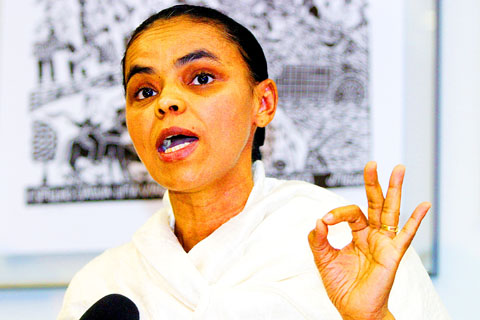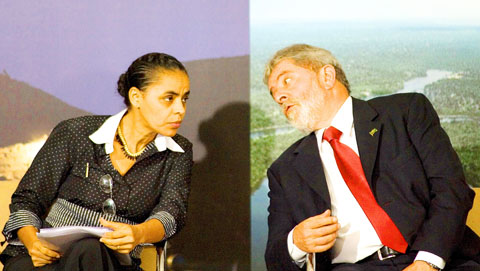Marina Silva will never forget the day the bulldozers rolled up on her family’s doorstep. It was the beginning of the 1970s and in the isolated Amazon community of Bagaco, where she was born, Silva, then about 12, looked on curiously as work began on a major highway to link the Brazilian rainforest with the rest of the country. Shortly afterwards, her relatives began to die. First two younger sisters, then her uncle and finally her cousin: all victims of a malaria epidemic imported by the road builders.
“I don’t know if I was conscious that the road was bringing all that, but it made me write on my own flesh the consequences of what it meant to mess around with nature without giving the slightest attention to the need to look after it,” she remembers.
Fast-forward to January 2003. Following the historic election of Brazil’s first working-class president, Luiz Inacio Lula da Silva, Silva was named environment minister, thrusting this former rubber tapper on to the front line of Brazil’s battle against deforestation — and of the fight against climate change.

PHOTO: AP
On May 13, however, the fairytale came to an abrupt end. After just over five years as environment minister, Silva resigned. In her short resignation letter, she cited “the growing resistance found by our team in important sectors of the government and society.”
“It’s time to start praying [for the rainforest],” said Sergio Leitao, director of public policy for Greenpeace in Brazil, claiming the government had “now made it clear that the idea of development at any cost is what will win out.”
A week after her resignation, a weary-looking Silva, 50, is unable to pinpoint a single cause for her decision. She is officially between jobs (she will return to her seat in the senate at the end of the month), but in her apartment in Brasilia, surrounded by half a dozen giant, multicolored orchids sent by well-wishers, she looks as busy as ever. She is careful not to name names but leaves little doubt as to why she abandoned the government of Lula, a longtime friend and ally from Brazil’s Workers Party.

PHOTO: AP
“I realized that I was no longer in a position to stabilize what had already been achieved and to carry on expanding these achievements,” she says. Seven days after resigning, she has still not seen the president, whom she has known for 30 years.
Silva’s resignation is the story of a conflict between two Brazils. In one corner are the farmers, businessmen and ordinary Brazilians who see the country’s natural resources as a route to economic success. In the other are the environmental activists, indigenous groups and concerned spectators who believe that Brazil’s march to economic greatness will mean the continued devastation of its rainforest. Silva attempted to tread a path between the two, trumpeting sustainable development. This, she said, would provide better living conditions for the 25 million people in the Amazon region without obliterating the rainforest.
But walking this tightrope was never going to be simple, even for the notoriously resilient Silva, who frequently cites Nelson Mandela as one of her inspirations.
Maria Osmarina da Silva was born in 1958 in a community of rubber tappers called Seringal Bagaco, deep in the western state of Acre. The nickname Marina stuck immediately. One of 11 children (three later died), she was orphaned at 16 and moved to the state capital, where she received a Catholic education and worked as a household maid.
Heavily influenced by liberation theology, she graduated in history from Acre’s Federal University at 26 and became increasingly politically active. In 1984 she helped create Acre’s first workers’ union.
From an early age Silva was considered a guerreira, a battler, overcoming numerous episodes of tropical diseases such as malaria, and later mercury poisoning. At 35, she was elected as the youngest female senator in Brazil’s history. She became a household name, famous for her shrill but powerful voice and unflinching defense of the Amazon. When Lula da Silva was piecing together his first cabinet, her name was reportedly at the top of his list.
It was a crucial moment: between 2001 and 2002, 26,000km² of rainforest had been lost. Illegal logging was spiraling out of control. A 40-year assault, led by loggers, ranchers and soy farmers had destroyed 20 percent of the Brazilian Amazon.
Last August, however, the government celebrated a 30 percent drop in rainforest destruction between 2006 and 2007 — the result, it said, of a plan launched in 2004, though many argued that the drop owed more to a fall in global commodity prices.
But the fault lines between Silva and other sectors of the government were becoming increasingly clear, most strikingly in relation to an economic plan unveiled in 2007. Designed to propel Brazil towards the same level of growth as Russia, India and China, it proposed constricting two massive hydroelectric dams in the Amazon. Activists claim the dams will displace thousands of people.
In January of this year, the tensions grew, following the release of satellite images, produced by the government, which showed a sudden spike in deforestation. Silva called a press conference, at which she blamed the destruction in part on soy farmers clearing more land for their crops. Her comments are reported to have infuriated Lula. Silva described the rise in deforestation as a “cancer;” Lula rebutted that it was an “itch,” at most a “little tumor.” It was becoming obvious that something had to give. Last week, in a move widely seen as a snub to Silva, Lula placed Mangabeira Unger, known for his controversial ideas on development and industrialization, in control of a new sustainable development scheme for the Amazon. Simultaneously, several Amazonian politicians, among them Blairo Maggi, one of the world’s leading soy producers, mounted a lobby to overthrow measures that banned banks from lending money to fund projects in areas of illegal deforestation.
“This was the last straw,” says Sergio Leitao of Greenpeace. “How many times was she forced to back down? She didn’t want to be responsible for this and so she said: ‘Not on my watch.’”
Still, Silva is upbeat. She talks of an awakening in Brazil and around the world, “a new political pact with society that wants Brazil to develop but with the preservation of the Amazon, the Atlantic rainforest, the savannah and of all our water reserves.” She is also adamant that this engagement has enabled a crackdown on the illegal loggers.
“Without the support of society it would have been impossible to have put 600 people involved in environmental crimes in the Amazon in jail,” she says. “This is something that is achieved by a new social pact that is appearing inside and outside of the country.”
While supporters have described her exit from power as a defeat for the green cause, she insists that progress is being made. “Today we are living through the challenge of prevention, of looking twice before doing something, discussing twice before doing something. Because each thing that we alter can lead to ... dramatic consequences. Those who celebrated the industrial revolution never thought that we were injuring the planet, almost fatally. We didn’t have this knowledge. Today we know.”

As I finally slid into the warm embrace of the hot, clifftop pool, it was a serene moment of reflection. The sound of the river reflected off the cave walls, the white of our camping lights reflected off the dark, shimmering surface of the water, and I reflected on how fortunate I was to be here. After all, the beautiful walk through narrow canyons that had brought us here had been inaccessible for five years — and will be again soon. The day had started at the Huisun Forest Area (惠蓀林場), at the end of Nantou County Route 80, north and east

Exceptions to the rule are sometimes revealing. For a brief few years, there was an emerging ideological split between the Democratic Progressive Party (DPP) and Chinese Nationalist Party (KMT) that appeared to be pushing the DPP in a direction that would be considered more liberal, and the KMT more conservative. In the previous column, “The KMT-DPP’s bureaucrat-led developmental state” (Dec. 11, page 12), we examined how Taiwan’s democratic system developed, and how both the two main parties largely accepted a similar consensus on how Taiwan should be run domestically and did not split along the left-right lines more familiar in

Specialty sandwiches loaded with the contents of an entire charcuterie board, overflowing with sauces, creams and all manner of creative add-ons, is perhaps one of the biggest global food trends of this year. From London to New York, lines form down the block for mortadella, burrata, pistachio and more stuffed between slices of fresh sourdough, rye or focaccia. To try the trend in Taipei, Munchies Mafia is for sure the spot — could this be the best sandwich in town? Carlos from Spain and Sergio from Mexico opened this spot just seven months ago. The two met working in the

This month the government ordered a one-year block of Xiaohongshu (小紅書) or Rednote, a Chinese social media platform with more than 3 million users in Taiwan. The government pointed to widespread fraud activity on the platform, along with cybersecurity failures. Officials said that they had reached out to the company and asked it to change. However, they received no response. The pro-China parties, the Chinese Nationalist Party (KMT) and Taiwan People’s Party (TPP), immediately swung into action, denouncing the ban as an attack on free speech. This “free speech” claim was then echoed by the People’s Republic of China (PRC),